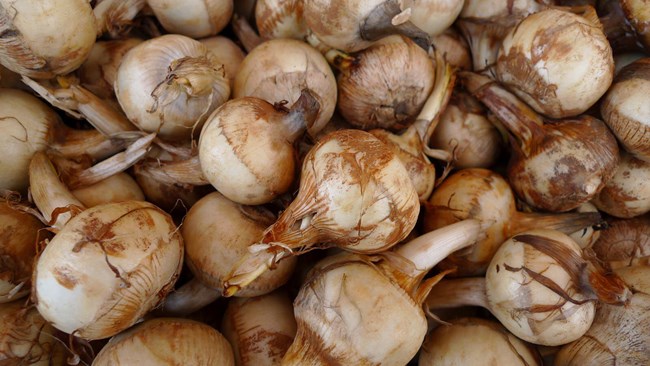Last updated: November 28, 2023
Article
Wapato

“the most valuable of all their roots is . . . The Wappetoe, or bulb of the Sagitifolia or common arrow head, which grows in great abundance in the marshey grounds of that butifull and fertile vally on the Columbia commenceing just above the quick Sand River and extending downwards for about 70 miles. this bulb forms a principal article of trafic between the inhabitents of the vally and those of [the] Sea coast.”—William Clark, January 22, 1806
The Lower Columbia River is a place of abundance, a place to find birds, waterfowl, seals, fish, and wapato.
Wapato is a plant that grows in freshwater marshy areas with an edible, starchy tuber. Clark commented that “those roots are equal to the Irish potato, and is a tolerable Substitute for bread”.
Indigenous people from downriver (Chinookan-speaking) and upriver (Chinookan- or Sahaptian-speaking), as well as up the Willamette River (Kalapuyan-speaking) came to the area around the Sandy River Delta to gather wapato, where it grew in great abundance. Wapato harvesting was so important along this stretch of the Columbia that Meriwether Lewis and William Clark referred to the large island near the mouth of the Willamette as “Wapato Island” (now known as Sauvie Island).
Clark recorded his observations of local women collecting wapato:
the womin collect by getting into the water, Sometimes to their necks holding by a Small canoe and with their feet loosen the wappato or bulb of the root from the bottom from the Fibers, and it imedeately rises to the top of the water, they Collect & throw them into the Canoe, those deep roots are the largest and best roots.
Chinookan families had special canoes for gathering wapato—light enough for one person to carry over land and big enough to carry lots of wapato back home.
Clark also noted how the wapato was prepared, with the root “they roste in hot ashes like a potato and the outer Skin peals off, tho this is a trouble they Seldom perform.”
In November 1805, when the expedition members voted where to establish a winter camp, Sacagawea wanted it to be in a place with lots of wapato to make sure they would have enough food. For diplomatic reasons and to have access to elk, the party decided to camp at Fort Clatsop, where they had to trade for wapato. Some Lower Chinook people sold it to them, while others refused because the visitors were offering prices too low for this valuable root vegetable.
